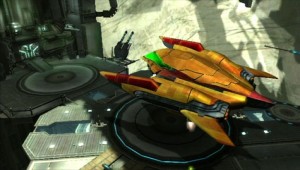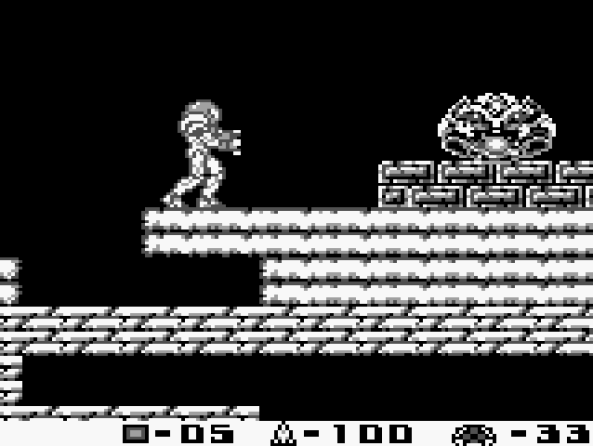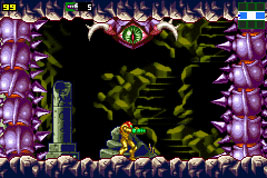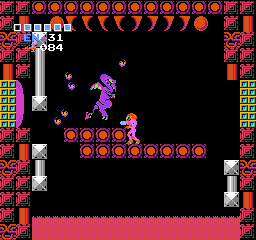
So I should apologize for the all-things-Metroid theme lately. For anyone not into the series, I understand that you probably want to claw my eyes out, desperately waiting for me to do Mega Man or Onimusha or…I don’t know…Nintendogs or something. For those of you who actually enjoy the series (or any series for that matter), you know that a good game functions much like a gateway drug; sure, it excites you at first, and maybe for a few times afterwards, but eventually the high wears off, causing you to smash your piggy bank, rifle your couch cushions and shakedown everyone you know for cash so you can branch out into similar, but harder relatives from the same family, trying to get that same fix. (Wow…once again, I compare video games to drugs. Maybe I should seek help?) But as I mentioned last week, Nintendo has only released five 2-D Metroid games. So when I’ve run through all of them, I have no option but to increase my dosage and spend more time in the basement hunched over my obsession, trying to sate myself. Eventually, trying to get that rush, I work my way up to speed…running, until all the time and energy I’ve spent on Metroid pay off with an aneurysm and I drop dead. They find my body weeks later, reaching for Trauma Center to no avail.

Oh! Behind you! Look Behind you! I told you not to go in there!
You laugh, but every three or four years, some poor, overworked teenager in Korea will spend three days straight in a PC Room playing Star Craft with nothing but ramen noodles and a haze of cigarette smoke for nourishment, and winds up dropping dead. I’d prefer to avoid that, so for a fresh, unsullied bout with 2D space pirates, I’ve resorted to something a little unorthodox, a ROM hack. Yes, I know that rom hacking only lies the width of a computer science degree away from fan fiction. But while I don’t exactly see the appeal in spending ten hours of my life reading about some ditzy teenager’s difficult choice between her torrid, wild affair with Legolas and her stimulating romance with Will Turner, programmers tend to keep themselves out of the story–often by keeping the story out of the game. So with a little research I discovered a highly recommended rom hack blending aspects of Zero Mission into the basic Super Metroid data.
And for those of you sick of Metroid reviews, good news! Super Zeromission has cured me of my desire for Metroid the way an angry father cures his teenager of the desire to smoke by making him suck down an entire carton of Camels in an hour!
 I’d like to establish first that Super Zeromission rivals canonical games for brilliance. While veteran players will easily note the basic data from Super Metroid, the hacker (or hackers) has (have) redesigned everything from the map to the basic sprite patterns, even utilizing some of the coding for enemies left unused in the original ROM. The game also drastically alters the original item acquisition order and adds in some new puzzles and door locks. This amounts to the game feeling new, something worth playing, and not just a burgeoning programmer trying to pass for clever by giving Samus an afro without actually changing the game.
I’d like to establish first that Super Zeromission rivals canonical games for brilliance. While veteran players will easily note the basic data from Super Metroid, the hacker (or hackers) has (have) redesigned everything from the map to the basic sprite patterns, even utilizing some of the coding for enemies left unused in the original ROM. The game also drastically alters the original item acquisition order and adds in some new puzzles and door locks. This amounts to the game feeling new, something worth playing, and not just a burgeoning programmer trying to pass for clever by giving Samus an afro without actually changing the game.

…you bastard.
It also follows a predictable logic. Let me explain; when I play a game, I assume at the very least that at least one person in the testing process has completed the game. And although weird stuff does crop up from time to time like giant ice keys or weird islands past the Archangel Dam, I can also reasonably assume that someone has solved all the puzzles, completed all the challenges, and not gotten stuck anywhere that would force them to restart the game. In short, if I get stuck, I can assume the developers made the game possible to complete, and that I just have to stop idling my brain in neutral in order to move forward. Now, I’ve edited entire books before, a process with all the enjoyment of separating beach sand into groups of different minerals with only a magnifying glass and a hand full of swollen fingers, and I’ve done it without experiencing the hulk-smash anger that washes over me every time I have to debug three or four lines of code. For a game ROM, not only does all the code need to work flawlessly, but it has to translate into a a flawless game world. Games demand layers of editing the same way a toddler expects you to give him food AND clean diapers, and they’ll both give you a massive headache if you deny it to them. Players should never have to resign a game because the developers let them get stuck. I often got stuck in Super Zeromission. In fact, I’d often get stuck in small areas, where I could only go back and forth between one or two rooms, usually with the only visible way out requiring an item that the jackass hacker wouldn’t give me for several more hours. Still, rather than assuming he screwed up, I could rely on a second, more hidden, method of escape. At moments like that, not only did I enjoy discovering a secret more difficult to find than anything Nintendo would dare put in a game, but I knew I found it only because the hacker trapped me in that room. I tip my hat to him/her for showing more brilliance in level design than the entire team at Nintendo.
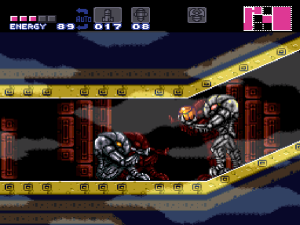 But I also wag my finger at the sadistic bastard for his unnatural love–nay, his fetish–for shinesparking. For those of you unfamiliar with the term, after reaching full speed with the speed booster, hitting the jump button will rocket you toward the heavens, allowing you to reach untold heights and smash through speed blocks. Further manipulation of this will let you dash horizontally, diagonally up, or let you spin jump and start the dash in midair. In most games, running with the speed boster will get you through all the required puzzles and shinesparking only lets you access a handful of secrets. It also usually drains your energy, but the hacker shut off that feature. Why? Because as previously mentioned, he doesn’t want you to get stuck anywhere, and almost all speed booster puzzles require shinesparking. Lots and lots of convoluted shinesparking. While it made parts of the game feel like a platformer, I will say that it forced me to look up detailed descriptions of how to properly perform the maneuver, as well as how to master the wall jump. Well done, hacker. You’ve become that one teacher everyone hates, but has to respect anyway for actually teaching me something.
But I also wag my finger at the sadistic bastard for his unnatural love–nay, his fetish–for shinesparking. For those of you unfamiliar with the term, after reaching full speed with the speed booster, hitting the jump button will rocket you toward the heavens, allowing you to reach untold heights and smash through speed blocks. Further manipulation of this will let you dash horizontally, diagonally up, or let you spin jump and start the dash in midair. In most games, running with the speed boster will get you through all the required puzzles and shinesparking only lets you access a handful of secrets. It also usually drains your energy, but the hacker shut off that feature. Why? Because as previously mentioned, he doesn’t want you to get stuck anywhere, and almost all speed booster puzzles require shinesparking. Lots and lots of convoluted shinesparking. While it made parts of the game feel like a platformer, I will say that it forced me to look up detailed descriptions of how to properly perform the maneuver, as well as how to master the wall jump. Well done, hacker. You’ve become that one teacher everyone hates, but has to respect anyway for actually teaching me something.
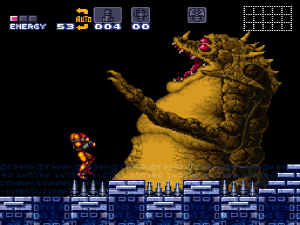
Fuck you, bitchtits! You fill your room with water and take away my platforms and I’ll make a suitcase out of you!
He/she also has some interesting ideas about how to rethink the purpose for item collecting. Take the varia and gravity suits, which allowed the player in Super Metroid to access new areas, increasing your exploratory capabilities (thankfully, the developers opted for the X-Ray scope instead of the colonoscope). The hacker lets you access all those areas even without the suit, and usually gives you a way to navigate through them. He even goes so far as to require you to do so. That when, when you finally do obtain those suits, you’ll appreciate them like a burn victim appreciates the Klondike. I do like the way he/she thinks, although I have to admit that between playing through water rooms without the gravity suit and my emulator lagging to begin with, the game felt like it moved by at the speed of the film “300.” Even when dry, the difficulty slowed the pace down to a painful crawl, and while I like the idea of worldwide locks that need releasing, but the releases gave no indication of whether or not you successfully released them. While I enjoyed the scenery redesign, it didn’t quite make up for the hours spent backtracking through a massive world map. Furthermore, the lack of walkthroughs online forced me to rely on youtube let’s play videos done by players who, to their credit, made me feel like Stephen Hawking by comparison.

Illustrating that a good game antagonist has more survival tricks than the Joker.
The story…well, the story doesn’t exist. The game lacks any of that fluff we may call “plot” that the other games seem to like so much. Hell, even the first two Metroid games had instruction manuals that listed off a premise. Super Zeromission seems to follow the structure of Zero Mission, so maybe we can use that premise and assume this is another remake. Or since the metroid larva appears and Zebes explodes at the end, maybe the hacker wanted to reboot Super Metroid. I don’t know. I don’t think it matters. You fight Kraid, Ridley and Mother Brain, in that order, but the hacker recycled Phantoon and Draygon, redesigning their sprites as the ghost of Mother Brain and an oddly crustacean-like Mecha Ridley, both fought in the second half of the game. While electing for a non-kosher final boss seems like an odd choice, I understand the difficulty in writing new code, and feel like I should respect that this hacker has at least some limits. Every single boss fight, though, adds something to it that makes the battles more difficult than in Super Metroid. Spore Spawn lives in a room with rising lava–somewhat of a questionable move for a plant–and only the Crocomire can stand on the floor in his chamber, while Samus has to settle for small platforms. Kraid has no more platforms, and you have to rely on the ice beam to let you stand on the crap he shoots out of his stomach. But, at the risk of going too long, the bosses accurately sum up the experience of the game; harder than most 2D Metroids, but in a constructive way that adds to the experience.
————————-
Play Online or Download Rom Here: http://www.letsplaysnes.com/download-metroid-super-zero-mission-rom/

So…replay value? Or does this intend to shame me with feelings of inadequacy?

So giant flabby monsters can stand on shoddy masonry, but Samus weighs so much she just goes crashing through?


Why, hello there. Just thought I might ask, you know…how do you operate the console without fingers?


































